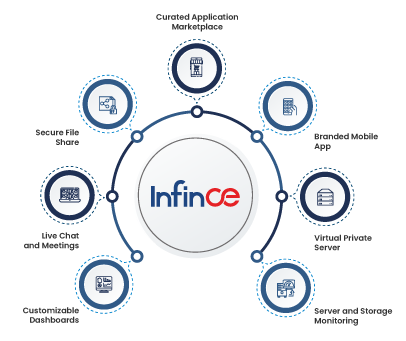Why Is The Public Cloud A Better Digital Transformation Option?
A decade ago, only a fraction of large scale enterprise applications, as well as consumer-facing applications, were in the cloud. Today, everything, from video and music streaming services to enterprise systems like ERP resides on cloud-based platforms. The large scale disruption that occurred due to the widespread adoption of cloud computing was the transition of one-time expensive licenses for software into highly affordable and flexible usage.
The benefits do not end with just cost but also the improved scalability that organizations were able to enjoy when their business or transaction volumes fluctuated during peak and non-peak market conditions. This is precisely the reason why the enterprise SaaS market is generating revenues of over $20 billion in a quarter for software vendors with a 32% year on growth. Industrial sectors ranging from banking to healthcare, retail, utilities, public services, and manufacturing have all made massive strides in cloud technology adoption. In fact, studies have shown that one-third of all IT budgets from enterprises now go into cloud solutions and platforms.
So cloud computing is here to stay and grow. The question now is what type of cloud, enterprises should invest in to ensure that their digital aspirations are offered the most compatible and progressive growth platforms. The major cloud options available for enterprises are public and private cloud systems. So what exactly are these? Here’s a brief explanation:
Private Cloud
A private cloud system is one that resides purely within an enterprise IT infrastructure and managed comprehensively by their own in-house technical team. From the deployment of applications to maintenance and upgrades, every activity that happens on such a cloud environment is owned, controlled and managed privately by the enterprise themselves. In short, the enterprise builds its own controlled cloud environment for internal usage and restricts any external access.
Public Cloud
A public cloud system is one in which your data and or applications reside on a cloud platform provided by reputed cloud vendors. The vendor is responsible for managing the data center requirements such as storage, application development support, processing and computing power, security and other infrastructural requirements.
So how can enterprises decide on choosing what’s best for their business? Let us examine the top 5 parameters every enterprise must evaluate before selecting their cloud infrastructure and how public and private cloud systems fare in each of these parameters.
1. Security
Every modern-day organization has to deal with truckloads of data that needs to be processed for decision making across different departments. When this entire process is transitioned into cloud-based systems where data is communicated over the internet, then security is a key concern. If an organization were to build their own private cloud infrastructure, then they would have to invest heavily on fortifying their cloud environment from threats. They could argue that external threats are lower than in the case of public cloud systems, but the effort involved in deploying and managing security protocols especially physical security of data centers is humongous.
Besides the right knowledge on how to thwart different levels of threats that arise in the industry from time to time will be limited if you engage internal staff to handle these security issues. As for a public cloud system, they would be aware of how to manage and neutralize the latest threats in the industry. In addition to that, the advantage of dedicated physically secure data centers, public cloud systems offer cloud infrastructure in your desired level of security preferences.
2. Technical Workforce Requirement
If your core business is non-IT, then the number of staff required to maintain a private enterprise cloud ecosystem within your business would be considerably larger if your business deals with a sizeable volume of IT transactions. This workforce requirement spans across different categories of IT technical staff like network administrators, physical and cyber security experts, database management teams, application maintenance and environment support teams, etc. Having a large dedicated IT workforce would result in significantly higher manpower requirements for a non-revenue, operational stream within your business and hence could impact staffing requirements across other key functions gradually due to budget constraints.
Additionally, your in-house technical team may not have access to industry awareness sessions and workshops that dedicated public cloud service providers offer to their staff. Hence, they would not be in a position to handle complexities that may arise from time to time. Public cloud service providers, on the other hand, invest in R&D, training and learning sessions to keep their workforce aware of what’s new and innovative in their industry. By preferring them over your own private cloud infrastructure, the knowledgeable workforce requirement challenge is mitigated considerably.
3. Scalable Infrastructure
Today’s businesses need a flexible technology infrastructure that can handle large fluctuations in their consumer demands and market conditions. For example, if you are an online retailer, then your technology backend will witness massive loads during the holiday shopping season and hence may need to scale up bandwidth, storage, computing, and analytical power, during this season. If you have private cloud infrastructure, then scalability will not be a flexible advantage since it would involve upgrading your own hardware infrastructure as well as other platform strengths to handle surges in usage.
Maintaining this high level of operational infrastructure all through the year is an expensive affair since the surge may be restricted to just a few months, but the hardware maintenance needs to be an ongoing activity all through the year. This is where public cloud systems offer an on-demand scalability advantage to your technology infrastructure. You can increase your cloud environment, performance, storage, and computing power in times of sudden business spikes and transit back to normal usage levels once the peak usage period is over. This will result in huge savings in terms of cost as well as management of cloud infrastructure as you only need to dynamically manage requests for increased transactions and not have the infrastructure boosted up always.
4. Ease of transitioning
Migrating your legacy on-premise system to a cloud-based platform is not a cakewalk activity. It involves careful planning, strategizing and prioritizing of business functions that need to be migrated to a cloud-based platform. If you are to building a private cloud system for everything, then the overheads involved in project management, application development, data migration, hosting and ultimately the availability of the system for consumer-facing business operations will be a challenging one.
If you opt for ready to deploy public cloud systems on the other hand, then all it takes is your data to migrate into the new cloud ecosystem after a small personalization or customization exercise. Or if you want to transition your proprietary enterprise applications in a cloud environment, then again the stability and support offered by public clouds can in no way be matched if you were to build a private cloud ecosystem to facilitate the transition.
5. Cost of Operations
The cost factor is a culmination of all the above parameters mentioned in this blog. As you can witness clearly, a private cloud requires quite a big investment to ensure that the organization’s technology infrastructure is on a secure and scalable cloud ecosystem with skilled and technically competent staff. This investment is not a one-time activity because technology evolves over time and you need to constantly transform with the changing technologies. With a public cloud system, you only incur the subscription cost while all other management and periodic feature upgrades are intelligently handled by the vendors themselves without passing on a heavy cost to users. This would mean that your organization would be able to significantly lower IT investments and hence core business operations would receive a higher budget allocation.
Related Reading: Migrate to the cloud efficiently! Check out our free guide to enable effective cloud transformation.
Thus, a public cloud system is the most feasible solution for enterprises to transit their digital assets into a cloud ecosystem. As more and more technology vendors bring newer innovations in the form of cloud-based ready to deploy platforms, it becomes easier for businesses to concentrate more on their core operational matters and less on their IT investments. With an infinite cloud platform like INFINCE, transform your business into a truly digital enterprise. Get in touch with us now!







